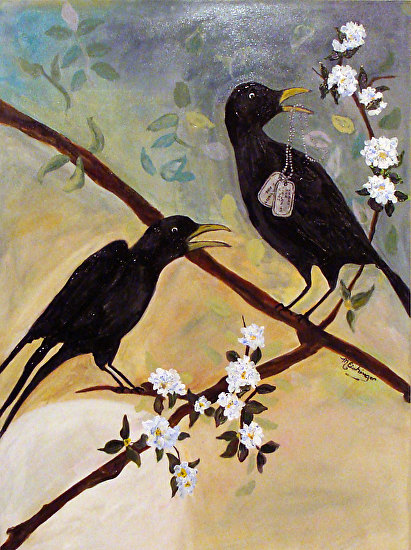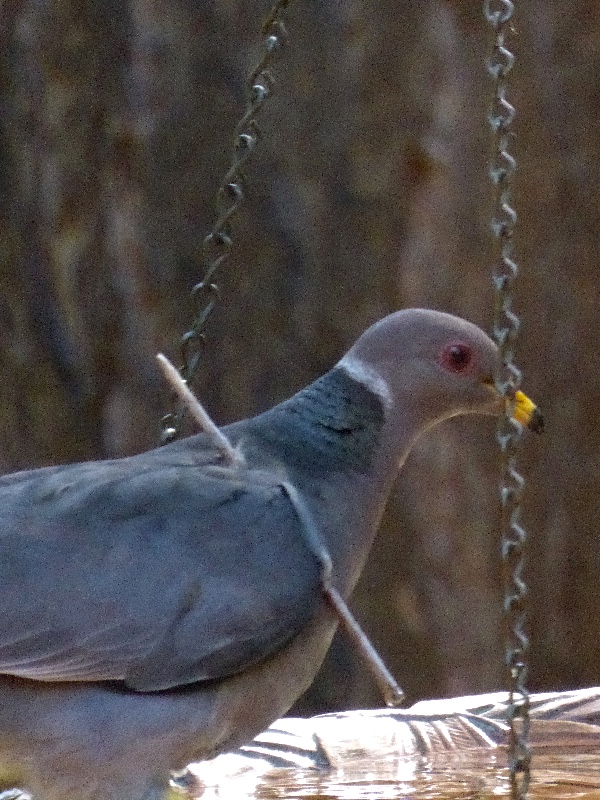
They’re big, black, smart, and noisy. Most of us recognize the short and long caw sounds of crows invading our neighborhoods. I’ve been on the park blocks in Portland when it was difficult to talk to the person standing next to me. Trying to understand what birds are saying is like trying to understand an alien language. But, with study, determination, and patience it can be done. And, doing so might keep them from going extinct.
Bird Talk
While hiking on Fairmont Boulevard last week I met a fellow traveler. A large raven landed seven feet ahead and to the right of where I walked. As I continued, the bird hopped ahead always keeping the same distance away from me. After ten minutes the bird changed tactics and flew onto a nearby branch. Flying from tree to tree slightly ahead, he waited patiently until I arrived. We continued to travel together for at least an eighth of a mile until another raven, perhaps his mate, lured him away.

I’m certain the raven was trying to communicate. His antics made me wonder if I had passed too close to his nest and he was luring me away. My partner thinks he wanted food, but I don’t agree. He never called, nor did he seem impatient. I’ll never know.
This was not the first time I watched a wild bird reach out. One time, when the bird feeder on our back deck was empty a Towee approached the sliding glass doors on our deck. Cocking his head he stared through the window with a pleading look that asked why the feeder was empty. We responded to his demand immediately and filled it with seeds he devoured.
The twittering sounds and body language of birds say a lot. Chirps, Cheeps, and melodies send messages that can be understood by humans. Some sing love poems designed to woo a mate while others use sound to show strength and warn unwanted birds to back off. Critters in the wild pay attention to their messages. Squirrels, for instance, respond to the short low-and high-pitched shrieks of robins indicating a predator like a coyote is in the area.
The Yao people in Mozambique team up with wild birds to find beehives. Scientists documenting the hunt for honey say it is a two-way relationship. The birds, wanting the combs inside the hives, can’t crack them open and risk being stung. So when they spot a hive they seek out human partners who will smoke out the bees and crack open the nests. The natives leave the combs for the birds to eat. And, when the people have a yen for honey, they make a “brr-hm” sound that calls out for bird assistance.
For the past twenty-five years, I’ve been entertained by watching birds at my feeder, though recently I’m seeing things that make me sad. I always looked forward to the return of the ring-necked pigeon from central America. A few years ago one arrived with a dart in his shoulder. How he managed to fly, eat and drink with a stick in his wing is hard to imagine. Birds hit by darts are in pain, subject to infection, and to becoming entangled or stuck in something. Unfortunately, blowgun injuries are being reported more often in the United States.

I consider shooting birds for pleasure to be malicious, yet expensive pigeon and dove hunting trips to Central and South America are increasingly popular. Though prices vary, a hunter will pay $1,725 for a two-day trip for a high volume (1000 birds) shooting in Montaraz, Argentina this fall. The cost excludes airfare, hotel room, hunting license, permits, and insurance). Pleasure hunters leave pieces of shot embedded in the birds, making the meat impossible to eat. They destroy an important source of food for native people living in the area.
It is not surprising that with activities like this there are fewer species at our feeder each year. Birds have rapidly been losing the habitat they need to live, find food, rest, and raise their young in safety. According to an article in USA Today, there are three billion fewer birds in North America than there were in 1970. They are being threatened by pesticides, free-roaming cats, wind turbines, insect decline, and disease. While the nation was concerned with COVID-19, Pine Siskins were also falling ill and passing their infection on to other birds. Early spring the Audubon Society asked people to stop filling their bird feeders. I found two dead Pin Siskins on my deck. Since then we have been careful to regularly clean our water tray and feeder.
Birds are also killed by moving vehicles that hit them when they are seeking food from road kills. It is a common end for Condors newly introduced into the wild. They land on large animals like deer and are not fast enough to escape a vehicle being driven seventy miles an hour. Birds are struck by planes more than 40 times a day and they fly into windows on houses and high-rise buildings. This was a problem at our house until we put an image of a hawk on our large picture window to stop birds from hitting it.
All of the problems mentioned are accelerated by climate change. Two-thirds of the continent’s bird species are at risk of extinction. In 2015, nearly 1 million common murres died at sea and drifted ashore, blighting beaches between California and Alaska. It was the largest mass die-off of seabirds in recorded history. When I was vacationing on the Oregon coast, my dog licked over a half-dozen murres scattered on the beach before I could pull him away. The next day my beautiful poodle was dead and I was in tears.
A warmer planet and expanding population are causing more wilderness land to be converted into farmable pastures. Breeding and nesting grounds are becoming agricultural fields and housing developments. “It’s a bird emergency,” says David Yarnold, CEO and president of Audubon. Yes, it is, I agree. And it’s like the canary brought into a coal mine to warn of what will happen to those who don’t pay attention.
While out walking, the raven I saw did nut vocalize but used body language to communicate with me. Rather than through words, he had a more concrete, sensory way to reach me. By doing so, he captured my attention and invited me to take him seriously. If I want to continue hearing birds sing, I will have to do more than I currently do to see that they survive.

A birdie with a yellow bill
Hopped upon my window sill,
Cocked his shining eye and said:
“Ain’t you ‘shamed, you sleepy-head!”
by Robert Louis Stevenson
from A Child’s Garden of Verses.
References:
Hammeri, tl (2017) More Pigeons With Blow Gun Dart Injuries Appear In The Castro, Mission. Hoodline. retrieved from https://hoodline.com/2017/05/more-pigeons-with-blow-gun-dart-injuries-appear-in-the-castro-mission/
Rice,D.(2019) There are 3 billion fewer birds in North America than there were in 1970. USA Today. retrieved from https://www.usatoday.com/story/news/nation/2019/09/19/3-billion-fewer-birds-north-america-now-than-1970/2365747001/
Woodward, A. (2020) An avian apocalypse has arrived in North America. Birdsong could become a rare sound. Business Insider. retrieved from https://www.businessinsider.com/birds-disappearing-in-north-america-2020-1
Jones, B. (2018) How to decode the secret language of birds. Popular Science. retrieved from https://www.popsci.com/learn-bird-language
MacDonald, F. (2016) Scientists Document Wild Birds ‘Talking’ With Humans for the First Time. Science Alert. retrieved from https://www.sciencealert.com/scientists-document-wild-birds-communicating-with-african-tribespeople-to-help-them-find-honey
Mertins,B. (2021) Do BIrds Have Language? Yes! AndIt’s Amazing What they Say . . .Nature Mentoring. retrieved from https://nature-mentor.com/birds-language/
(2011) Language and Culture of Crows. Crows.net. Retrieved from http://www.crows.net/crows.html
Pepperberg, I (2008) Alex & Me: How a Scientist and a Parrot Discovered a Hidden World of Animal Intelligence—and Formed Deep Bond in the Process. ISBN 978-8-06-167398-6. HARPER.
